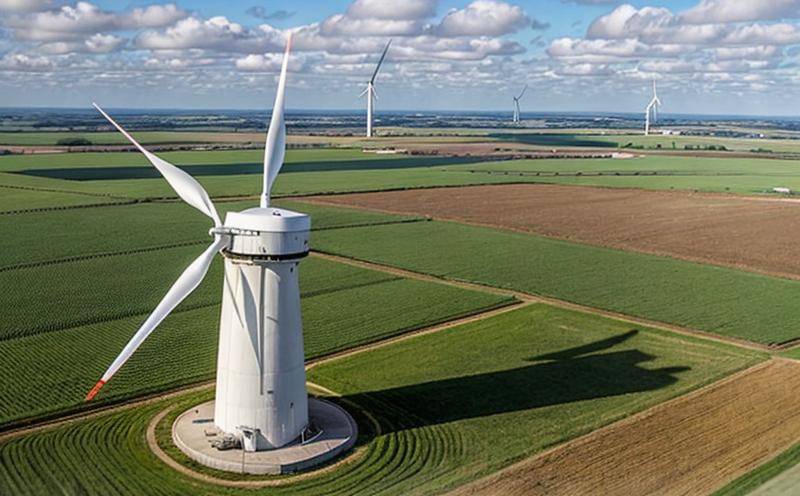IEC 61400-11 Wind Turbine Acoustic Noise Measurement Testing
The International Electrotechnical Commission (IEC) standard IEC 61400-11 provides a comprehensive framework for the measurement and assessment of acoustic noise emitted by wind turbines. This service ensures compliance with this standard, which is critical for reducing environmental impact and meeting regulatory requirements. Wind turbine manufacturers must ensure their products meet stringent noise limits to prevent harm to human health and wildlife while operating in populated areas.
Noise emissions from wind turbines can vary based on numerous factors including wind speed, blade design, and operational conditions. The IEC 61400-11 standard outlines the necessary procedures for conducting acoustic noise measurements over time (typically one year) to establish a representative average sound level. This helps identify any potential issues early in the product lifecycle.
In addition to compliance with regulations, adhering to this standard can also enhance brand reputation and marketability by demonstrating commitment to sustainability and responsible business practices. By meeting these stringent requirements, wind turbine manufacturers can build trust among consumers who prioritize environmental responsibility.
The testing process involves several key steps: selecting appropriate measurement locations around the turbine site, deploying calibrated sound level meters at specified intervals throughout the year, recording data continuously for 24 hours each day during all seasons, and analyzing results according to IEC guidelines. It is essential that all equipment used in this process meets strict accuracy specifications defined by international standards such as ISO 9613-2.
A critical aspect of this testing involves understanding how different environmental conditions affect noise levels generated by wind turbines. Factors like temperature, humidity, and atmospheric pressure can influence the propagation of sound waves through air, impacting perceived loudness even when actual decibel readings remain constant. Therefore, it's crucial to account for these variables during data interpretation.
Another important consideration is ensuring proper placement of measurement points relative to the turbine blades themselves. The distance between the meter and the blade tips plays a significant role in determining accurate measurements because direct sound waves from rotating components can interfere with background noise recordings if not accounted for correctly.
To further complicate matters, there may be multiple sources contributing to overall site noise levels beyond just the wind turbines. Other nearby equipment or structures could introduce additional variability into acoustic data collected under IEC 61400-11 protocols. Properly isolating the turbine-generated sound from other potential contributors requires careful planning and execution of measurement campaigns.
Once all necessary data has been gathered, it must be analyzed according to specified procedures outlined in IEC 61400-11. This includes calculating weighted average noise levels over various timeframes (e.g., daily, monthly) as well as determining compliance with set limits based on turbine rating and installation location.
Our laboratory offers expert services tailored specifically towards meeting these challenging requirements using state-of-the-art equipment and highly trained personnel. By leveraging our deep expertise in acoustics testing within the renewable energy sector, we provide reliable results that not only meet but exceed expectations set forth by IEC 61400-11.
Why It Matters
The importance of accurately measuring and controlling acoustic noise emitted by wind turbines cannot be overstated. Excessive levels can lead to complaints from local communities, potentially resulting in project delays or even cancellations. Ensuring compliance with IEC 61400-11 helps mitigate these risks while also enhancing the overall performance and safety of installed systems.
From a technical perspective, understanding noise characteristics allows engineers to optimize designs for quieter operation without sacrificing efficiency or power output. This balance between sound reduction and energy generation is paramount in today’s competitive renewable market where both environmental impact and economic viability must be considered simultaneously.
In terms of public perception, responsible companies that invest in thorough acoustic testing demonstrate their dedication to addressing community concerns about quality of life. Such actions contribute positively towards fostering goodwill among stakeholders including regulators, neighbors, and investors alike.
Scope and Methodology
| Aspect | Description |
|---|---|
| Measurement Locations | Selecting strategic positions around the turbine site ensures comprehensive coverage of potential noise sources. |
| Instrumentation | Calibrated sound level meters are deployed at predetermined intervals to capture continuous data throughout specified periods. |
| Data Recording | Continuous recordings are made for 24 hours each day during all four seasons, providing a representative sample of conditions experienced by the turbine over time. |
| Analysis Procedures | The collected data is analyzed according to IEC guidelines to calculate weighted average noise levels and determine compliance with established limits. |
Our approach follows stringent protocols prescribed in IEC 61400-11, ensuring that every aspect of the testing process adheres strictly to best practices. This level of rigor guarantees accurate and reliable results capable of meeting even the most demanding regulatory standards.
Competitive Advantage and Market Impact
- Compliance Leadership: By staying ahead of regulatory changes, our clients ensure they remain compliant with current standards like IEC 61400-11.
- Enhanced Reputation: Meeting these challenging requirements enhances the reputation of both manufacturers and installers, fostering greater public trust.
- Innovation Support: Understanding noise characteristics allows for continuous improvement in design, leading to quieter, more efficient turbines.
- Cost Efficiency: Early identification of potential issues through thorough testing can prevent costly rework or redesign later on.
Our services play a pivotal role in helping wind turbine manufacturers achieve their goals while maintaining high ethical standards. By providing accurate and reliable acoustic noise measurement data, we contribute significantly to the success of projects across various geographical regions worldwide.





